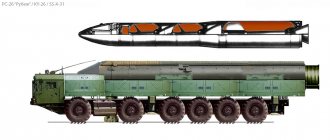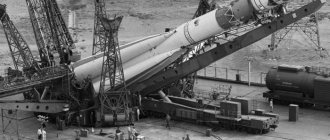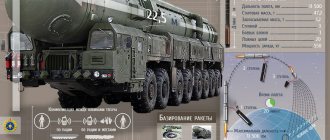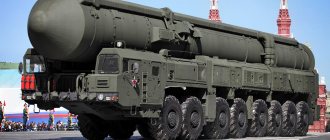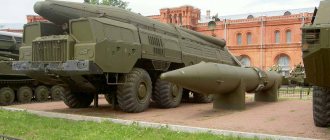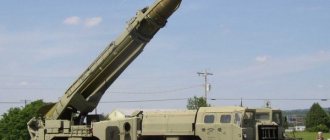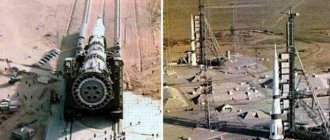The inheritance of the Soviet Union has long since exhausted its technological resource, so the Russian Strategic Missile Forces, abbreviated as Strategic Missile Forces, need new and effective means of delivering nuclear warheads. The silo-based missile systems currently in service continue to be serious and formidable weapons. The RT-2PM and RT-2PM2V missile systems, a mobile version and in a silo version, are considered no less effective. Despite its rather powerful nuclear arsenal, in modern conditions Russia is forced to modernize its nuclear arsenal. The Yars mobile missile systems that recently entered combat duty are the first step towards the restoration of strategic nuclear forces. The introduction of the latest RS 26 missile systems will allow us to consolidate the achieved result and increase the country’s defense capability.
The tasks set for the creators of the new rocket were successfully completed and implemented in the project. The new Russian missile should not only replace outdated strategic missile systems, but also increase the combat potential of the land component of the Russian nuclear triad. The result was the new Rubezh missile system, the name of which alone speaks volumes about the technical characteristics and combat capabilities of the new missile technology. Technologically new weapons were created in such a way that the Strategic Missile Forces could quickly carry out rearmament and switch to new types of equipment. The main aspect that is strictly observed during the commissioning of the new RS 26 ICBM is to maintain the level of defense sufficiency that the Strategic Missile Forces currently enjoy.
What is the new weapon?
The reasons that prompted the Russian top military leadership to begin creating a new strategic missile system are pragmatic in nature. In conditions where the development of nuclear missile weapons continues to be affected by the START-2 Treaty, non-standard solutions and steps are required to maintain the country’s nuclear missile potential at the proper level. It was from this perspective that a new combat missile was created, with technical characteristics that did not go beyond the current restrictions. The result exceeded all conceivable and unimaginable expectations. The Russian RS 26 missile coded “Rubezh” became an unpleasant surprise for overseas strategists. Despite the enormous combat power and high flight characteristics, Russian designers managed to create military weapons capable of nullifying all the efforts of the Americans and their allies to create a new missile defense system.
A fundamentally new approach to creating rocket engines and equipping the rocket with a new control system made it possible to achieve such success. New technology has made it possible to create a high-precision mobile-based missile system. Due to the fact that the project initially decided to abandon the creation of a universal launch vehicle, it was possible to achieve a significant reduction in the launch vehicle’s launch weight. This, in turn, provided ample technological opportunities for the creation of a small-sized mobile missile system, the favorite weapon of Soviet and Russian rocket scientists.
The creation of the new complex began in 2006. Traditionally, the development of the project was carried out by the Moscow Institute of Thermal Engineering, the leading research and production enterprise in the country, specializing in the creation of rocket technology.
A number of other enterprises and organizations in the country were involved in the work of the institute. Up to 25 enterprises of the domestic defense complex participated in the topic, which received the code “Frontier”. In the process of close cooperation and fruitful teamwork, the RS 26 ballistic missile project soon emerged - a fundamentally new weapon for domestic rocket technology. Even at the design stage, the Russian development received the designation SS-X-29 in the West. The prefix “X” denoted the presence of hidden technical characteristics, which, according to Western experts, the Russian missile had.
The main difference that confused overseas strategists was that the Russian new product had a completely different control system. The missile was controlled during the active flight phase, which was previously the most vulnerable part of the flight of any ballistic missile. With the creation of new anti-missile missiles, the power of nuclear arsenals was called into question, since after a combat launch the launch vehicle could be shot down even above the launch site. Russian designers were able to obtain this advantage through the use of new fuel. In addition to this, the propulsion engines have also been significantly modified. Instead of a 25-minute active flight phase, the new Russian rocket had a shorter active flight phase.
In other words, in layman's terms, the third stage of the rocket is fired at intervals, imparting a certain impulse to the head of the rocket. The result of this design was the invulnerability of the warhead, which can independently perform anti-missile maneuvers.
Unlike silo-based launch vehicles, the newest Russian rocket lacks stability elements in its design. Those. the rocket body and its stages resemble in shape and configuration the launch vehicles used for launching from an SSBN. This was the reason that the complex was created only in the mobile version.
Coastal missile system "Rubezh"
In 1960, the P-15 anti-ship cruise missile was adopted by the Soviet Navy, which became the main strike armament of boats of several projects. Soon after this, work began to improve such weapons, which led to the appearance of several new missiles and complexes. Thus, for coastal missile forces and artillery, the Rubezh mobile complex was created, armed with the latest modification of the P-15 missile. By the early seventies, the coastal troops of the USSR Navy were armed with two mobile missile systems with anti-ship missiles. These were the Sopka systems with the S-2 missile and the Redut complex with the P-35B missile. The complex based on the S-2 projectile aircraft (a modified version of the aviation KS-1 “Kometa”) was already considered obsolete. The newer "Redoubt" also did not fully suit the military. Due to the large size of the rocket, only one launcher could be placed on a self-propelled chassis without any additional equipment, which required the inclusion of a separate control vehicle into the complex. In new projects of mobile missile systems, it was necessary to solve this problem and place both missiles with launch systems, a target search radar, control equipment, etc. on a single chassis.
The development of a new rocket for the promising complex was considered inappropriate. The new system should have been built on the basis of one of the existing products of the latest models. The requirements for placing all elements of the missile system on one vehicle led to the need to use relatively light and small-sized missiles. The P-15M “Termite” product, developed in the mid-sixties, most fully met these requirements.
Launch of a P-15M missile using the Rubezh complex. Photo by Wikimedoa Commons
The new project of the coastal missile system received the symbol “Rubezh”. Subsequently, the complex received the GRAU index 4K51. The development of the system was entrusted to the Raduga machine-building design bureau (MCB), which was previously a branch of OKB-155. In addition, some related enterprises were involved in the work. In particular, the Moscow Mechanical Engineering Design Bureau was responsible for the development of the new launcher, and the base chassis was to be provided by the Minsk Automobile Plant.
The main element of the promising Rubezh missile system was to be the existing P-15M cruise missile. This product was a deep modernization of the basic P-15 missile and differed from it by higher characteristics, which were achieved through minor design modifications and changes in the composition of the equipment. In particular, with the help of these changes it was possible to increase the maximum firing range from 40 to 80 km. Some other components of the project were also reworked.
The P-15M rocket had an elongated round fuselage with an ogival head fairing and a conical tail section. It received a mid-mounted, highly swept trapezoidal wing, equipped with a folding system. In the transport position, the wing consoles were lowered down and thereby reduced the dimensions of the product. After leaving the launch container, the automation had to open the wing and fix it in that position. In the rear part of the fuselage there was a tail unit in the form of one keel and two stabilizers installed with a large negative V. The tail planes had a trapezoidal shape and a large sweep of the leading edge. The tail was mounted rigidly and could not be folded.
To control during flight, the P-15M rocket had to use a set of rudders placed on planes. The wing had ailerons for roll control, altitude control was carried out using rudders on the stabilizer, and there was a rudder on the fin. All available rudders allowed the rocket to maneuver, maintaining the required course or aiming at the target.
The power plant of the Termit rocket consisted of two main blocks. For initial acceleration, exit from the launcher and climb to flight altitude, a solid propellant starting engine SPRD-192 with a thrust of 29 tons was proposed. It was made in the form of a cylindrical block with a nozzle in the tail section and mounts for mounting on the rocket fuselage. After running out of fuel, the starting engine had to be reset. The further flight was carried out using a propulsion propulsion system.
The P-15M had a S2.722 liquid propellant rocket engine running on TG-02 fuel (samin) and an AK-20K oxidizer based on nitric acid. The engine had two operating modes, accelerating and maintaining speed, intended for use at different stages of flight. The engine's task was to accelerate the rocket to a speed of 320 m/s and maintain such flight parameters until it hits the target.
P-15M missile being loaded onto a missile boat. Photo Rbase.new-factoria.ru
The onboard missile control system included an APR-25 autopilot, an RV-MB radio altimeter, an inertial navigation system and a homing head of one of two types. The basic modification of the missile received an active radar seeker of the DS-M type. The second version of the weapon was equipped with a thermal seeker "Snegir-M". The control systems ensured that the missile could independently reach the target area, followed by studying the water area and searching for a target to attack. In the final section, using the seeker, they ensured the missile was aimed at the target.
The P-15M rocket had a total length of 6.65 m, a body with a diameter of 0.76 m and a wing span (in flight position) of 2.4 m. The launch mass of the rocket with an accelerator reached 2573 kg. In the central part of the fuselage there was space for installing a 4G51M high-explosive cumulative warhead weighing 513 kg or lighter special ammunition with a power of 15 kt.
Using a radar altimeter, the Termit missile was supposed to fly at altitudes of no more than 250 m, while the recommended altitudes were in the range of 50-100 m. The cruising speed during the cruising phase of the flight was 320 m/s. The fuel supply was enough for a flight of up to 80 km. Detection of a destroyer-type target by a radar homing head was carried out at a range of up to 35-40 km. The characteristics of the thermal seeker were several times lower.
To use the existing missile, coastal troops required a self-propelled launcher and a set of related equipment. Through the efforts of several organizations involved in the Rubezh project, the 3P51 combat vehicle was created. When designing it, all the basic requirements for the promising complex were taken into account regarding the set of equipment on the base chassis.
The four-axle special chassis MAZ-543 was chosen as the basis for the 3P51 self-propelled launcher. Such a vehicle, equipped with a 525 hp engine, had a payload capacity of more than 20 tons and could be used as the basis for various military and auxiliary equipment. An important feature of the selected chassis was the presence of a large cargo area to accommodate the necessary equipment, which was proposed to be used in the new project.
Scheme of the 3P51 self-propelled launcher. Drawing by Shirokorad A.B. "Weapons of the domestic fleet"
Directly behind the cabin of the base vehicle, on the loading platform of the 3P51 vehicle, an operator’s cabin was located, made in the form of a KUNG-type van. Inside the cabin there were blocks of electronic equipment for searching for targets, processing data and controlling the missile. In addition, in the niche of the roof of the cab van, there was space for stowing a lifting mast with an antenna for the 3Ts51 Harpoon detection radar. In preparation for combat work, the mast had to take a vertical position and raise the antenna to a height of 7.3 m, ensuring the functioning of the station. It should be noted that the cockpit equipment of the Rubezh complex was slightly redesigned fire control equipment borrowed from Project 205U missile boats. It is probably this particular feature of the project that led to the fact that the concept of a self-propelled launcher with its own radar and control devices received the unofficial name “boat on wheels.”
New KT-161 launchers were developed specifically for the Rubezh missile system. They were pentagonal containers with sliding lids. Inside such a container there were short “zero” guides for mounting missiles. In addition, connectors were provided for connecting the missile’s onboard equipment with the launcher’s control devices. The KT-161 container had a length of 7 m and a width of 1.8 m. The diameter of the launcher was reduced thanks to the use of automatic wing deployment, which made it possible to reduce the dimensions of the missile in the transport position.
At the rear of the base chassis it was proposed to install a lifting and rotating device with fastenings for two KT-161 launch containers. In the stowed position, both containers had to be placed along the chassis, with the front cover back. In preparation for firing, the automation ensured that the launcher was rotated at an angle of 110° to the right or left from its original position and the container was raised by 20°, followed by opening the lids. After this, a launch command could follow.
The 3P51 self-propelled launcher is capable of carrying two P-15M missiles and a crew of six people. The combat weight of such a vehicle slightly exceeds 40 tons. The length of the vehicle in the stowed position is 14.2 m, the width is no more than 3 m, and the height is 4.05 m. Depending on the modification of the base chassis, the launcher is capable of reaching speeds of up to 60-65 on the highway km/h The power reserve reaches 630 km. After arriving at the combat position, the crew of the vehicle must carry out work to deploy the complex, for which no more than 5 minutes are allotted.
In addition to the self-propelled launcher, the Rubezh complex included a transport vehicle designed for transporting missiles and servicing other systems. To transfer missiles from a transport vehicle to a launcher, cranes on a vehicle chassis must be used. If it is necessary to control relatively large water areas, additional surveillance radars of various types could work with the Rubezh complex, complementing the existing 3Ts51 Harpoon system.
The launcher is in firing position (no missiles). Photo: Wikimedia Commons
The composition of the equipment of the 3P51 machine ensured that all basic operations were performed exclusively by crews without the need to involve third-party tools and complexes. Having moved into position and deployed the complex, the crew had to use the Harpoon radar to monitor the covered water area. When a potentially dangerous object was detected, state identification equipment should be used and a decision should be made to carry out an attack. It was also possible to use third-party target designation.
Using the Harpoon radar and existing fire control devices, the complex operators had to calculate the flight program for the autopilot and enter it into the rocket’s memory. Then the command should be given to launch one or both missiles placed on the launcher. In this case, it was proposed to use a missile whose homing head most corresponded to the current tactical situation and could ensure effective destruction of the target.
Having received the command to launch, the P-15M rocket had to turn on the launch and sustainer engines. The launcher's task was to initially accelerate the product with removal from the launcher and rise to a low altitude. After this, it separated, and the flight continued with the help of the main engine. The launch phase of the flight had to be carried out in the booster mode of the main engine, and after reaching a speed of 320 m/s, the rocket switched to the speed maintenance mode.
The first half of the flight, to a pre-calculated point, was carried out using the autopilot and inertial navigation system. Having reached the target area, the missile had to turn on the homing head and search for the target. At the same time, the active radar seeker of the DS-M type could find destroyer-type targets at distances of up to 35-40 km, while the infrared Snegir-M coped with this task only at a distance of 10-12 km. The final leg of the flight followed the commands of the homing head. Along the entire route, the rocket had to use a radio altimeter, with the help of which the flight altitude specified by the operator was maintained. Low-altitude flight made it possible to increase the likelihood of successfully breaking through enemy defenses.
To increase the effectiveness of the attack, the missile autopilot, at some distance from the target, had to perform a “slide” with the aim of hitting the enemy ship from above. With such a hit, the high-explosive cumulative warhead was supposed to inflict the maximum possible damage. To significantly increase the impact on the target and objects at some distance from it, it was proposed to use a special warhead with a power of 15 kt.
Loading a rocket into a launcher. Photo Warships.ru
The preliminary design of the 4K51 Rubezh complex was prepared by the end of 1970. The following year it was defended, which allowed the development of design documentation to begin. By the middle of the decade, a new type of coastal missile system was ready for testing. The 1267th separate coastal missile division was formed in 1974 specifically for test firing within the Black Sea Fleet. Soon the personnel of the formation began to master the new material and prepare to participate in the tests.
At the end of 1974 (according to other sources, at the beginning of 1975), the first tests of the Rubezh complex with throw missile launches took place at one of the Black Sea Fleet training grounds. After four such tests, full-fledged checks began with the launch of serial P-15M missiles. Until 1977, 19 test launches were carried out, some of which ended in successful destruction of training targets. Based on the test results, the new coastal complex was recommended for adoption.
On October 22, 1978, the Council of Ministers of the USSR decided to adopt the Rubezh complex into service with the coastal missile forces and naval artillery. By this time, the industry was ready to begin mass production of new systems and deliver them to the customer. Soon after this, the troops began to master new complexes.
The optimal composition of formations armed with the Rubezh was determined as follows. Four launchers with transport vehicles and truck cranes were combined into a missile battery. Batteries, depending on tactical need, could be organized into divisions and regiments. An important feature of the new complex, which greatly facilitated its operation, was the complete autonomy of the 3P51 combat vehicles. The detection equipment, the control cabin, and cruise missiles were located on one chassis. Thanks to this, self-propelled launchers could solve assigned tasks independently, without the need for additional detection means. However, strengthening the batteries with additional radars was not ruled out.
To increase the combat effectiveness of coastal systems, it was proposed to form an ammunition load of missiles with different guidance systems. One of the missiles loaded into the launcher was supposed to have an active radar seeker, the second - a thermal seeker. Thanks to this, the crew had the opportunity to choose the most effective means of hitting a found target, or to increase the likelihood of its destruction by simultaneously launching missiles with different guidance methods, including when the enemy uses jamming.
In the early eighties, the Rubezh complex was modernized, as a result of which the 3P51M self-propelled launcher appeared. Its main difference from the base 3P51 was the chassis of the new model. This time, a four-axle MAZ-543M chassis was used, which differed from the previous vehicle in its improved characteristics. Other elements of the missile system remained without major innovations, which made it possible to maintain their characteristics at the same level.
The 3P51 launcher is in firing position: the radar antenna is raised, the missile container is open. Photo Rbase.new-factoria.ru
Coastal missile systems "Rubezh" of both modifications were supplied to all fleets of the USSR Navy. In total, several dozen launchers and a significant number of missiles for them were built and delivered. After the collapse of the Soviet Union, the available complexes were divided between the coastal forces of Russia and Ukraine. The systems of the Baltic Fleet were not divided between the newly formed states, since they were brought to Russian territory in time. According to available data, the Russian fleet currently has at least 16 3P51 vehicles, which are operated by four separate missile units across all fleets.
It is known that the Rubezh complex was initially considered as a potential product for sale to friendly countries. After completing the main deliveries in the interests of its own fleet, Soviet industry began production of export complexes. These systems were sent to friendly states in the Middle East, North Africa, and Eastern Europe. Among others, similar equipment was ordered by the GDR, Romania, Algeria, Syria, Yemen, Libya, etc. In some countries, Soviet-made Rubezhi missiles have already been withdrawn from service, while in others they are still in use.
The long-term operation of such systems may be hampered by the lack of necessary cruise missiles. Assembly of P-15M products continued until 1989, after which they were discontinued in favor of newer and more advanced missiles. Thus, at present, all operators of the Rubezh complexes and other systems using missiles of the P-15 family are gradually using up the last of such products, which are also reaching the end of their shelf life.
The Rubezh coastal missile system had both pros and cons. The positive features of this system are visible when compared with its predecessors. Thus, the new Rubezh differed from the Sopka and Redut complexes in a significantly smaller number of means: it consisted only of a launcher and several auxiliary vehicles. Also a big plus was the use of a launcher with two containers, which gave corresponding advantages over existing systems.
Naturally, there were some downsides. One of the main ones is the relatively short firing range. In this parameter, the P-15M missile, which appeared in the mid-sixties, was noticeably inferior to newer systems that were put into service simultaneously with the Rubezh complex. In addition, over time, certain problems with resistance to interference used by the enemy have appeared. Despite the high performance characteristics at the time of its appearance, the Termit rocket over several decades of operation managed to become outdated and lose all its advantages.
Coastal missile systems 4K51 "Rubezh" are still in service with several countries. These systems are used to protect maritime borders and can still carry out assigned combat missions. However, their characteristics no longer fully meet the requirements of the time, the material part is physically aging, and the number of usable missiles is constantly decreasing. In the foreseeable future, such complexes may be decommissioned and finally replaced by newer analogues. However, over several decades of service, the Rubezh complexes have become an important element of coastal defense and deservedly take their place in the history of domestic missile weapons.
Based on materials: https://rbase.new-factoria.ru/ https://vpk-news.ru/ https://warships.ru/ https://militaryparitet.com/ Shirokorad A.B. Weapons of the domestic fleet. 1945-2000. – Mn.: “Harvest”, 2001
Details and design features of the newest rocket
New weapons were not created from scratch. The groundwork for structural strength and manufacturability was made on the Topol and Yars missile systems. It was these systems that provided the necessary technical basis for the new complex. Traditionally, a launch vehicle is a multi-stage rocket in which a special warhead distributing module is installed. From a design point of view, the brainchild of the Moscow Institute of Thermal Engineering is a modernized and improved Bulava sea-based missile, from which the first two stages are taken. The third stage is hidden in a special midsection. This innovation is due to the fact that the warhead will be equipped with homing warheads capable of independent maneuvering.
The created RS 26 missile system has the following tactical characteristics:
- rocket launch weight 30-40 tons;
- the mass of the entire missile system on the chassis is 80 tons;
- the carrying capacity of a self-propelled tractor with a 12x12 wheel arrangement is 50 tons;
- the length of the launch container is 13 meters;
- maximum flight range 6-8 thousand km;
- minimum range is not less than 2 thousand km.
The new Russian missile can have two variants of combat equipment, a single warhead or multiple warheads (MRV) with individual guidance. The latter option looks preferable, however, due to some technological limitations, the emphasis is on equipping the launch vehicle with a single warhead.
The starting container has a traditional design with or without a cap.
ZhRD3D39 main engines operate on a new liquid fuel, which contains high-temperature components that ensure unstable operation of rocket engines. The new composition of the rocket fuel allows the engines to be switched on and off at different flight modes to carry out anti-missile maneuvers.
The transport base and the mobile launch complex itself deserve special attention. As before, a wheeled tractor of the MZKT brand with a 650 l/s engine is used for this purpose. These powerful transporters were first tested on the Pioneer missile systems. The new vehicle had to have the same cross-country ability, be maneuverable and have a lower carrying capacity. To increase maneuverability, the tractors had 4 axles controllable at once: 1, 2, 5 and 6. Belarusian automakers managed to create a tractor that fully meets the objectives set in the project.
An excerpt characterizing the RS-26
Having overtaken all the battalions in front, he stopped the 3rd division and became convinced that, indeed, there was no rifle chain ahead of our columns. The regimental commander of the regiment in front was very surprised by the order given to him from the commander-in-chief to scatter the riflemen. The regimental commander stood here in full confidence that there were still troops ahead of him, and that the enemy could not be closer than 10 miles. Indeed, nothing was visible ahead except a deserted area, sloping forward and covered with thick fog. Having ordered on behalf of the commander-in-chief to fulfill what had been missed, Prince Andrei galloped back. Kutuzov stood still in the same place and, senilely slumped in the saddle with his corpulent body, yawned heavily, closing his eyes. The troops no longer moved, but stood at gunpoint. “Okay, okay,” he said to Prince Andrei and turned to the general, who, with a watch in his hands, said that it was time to move, since all the columns from the left flank had already descended. “We’ll still have time, Your Excellency,” Kutuzov said through a yawn. - We'll make it! - he repeated. At this time, behind Kutuzov, the sounds of regiments greeting each other were heard in the distance, and these voices began to quickly approach along the entire length of the stretched line of advancing Russian columns. It was clear that the one they were greeting was traveling quickly. When the soldiers of the regiment in front of which Kutuzov stood shouted, he drove a little to the side and looked back with a wince. On the road from Pratzen, a squadron of multi-colored horsemen galloped along. Two of them galloped side by side ahead of the others. One was in a black uniform with a white plume on a red anglicized horse, the other in a white uniform on a black horse. These were two emperors with their retinue. Kutuzov, with the affectation of a soldier at the front, commanded the troops standing at attention and, saluting, drove up to the emperor. His whole figure and manner suddenly changed. He took on the appearance of a commanding, unreasoning person. With an affectation of respect that obviously struck Emperor Alexander unpleasantly, he rode up and saluted him. An unpleasant impression, just like the remnants of fog in a clear sky, ran across the emperor’s young and happy face and disappeared. He was, after ill health, somewhat thinner that day than on the Olmut field, where Bolkonsky saw him for the first time abroad; but the same charming combination of majesty and meekness was in his beautiful, gray eyes, and on his thin lips, the same possibility of varied expressions and the prevailing expression of complacent, innocent youth. At the Olmut show he was more majestic, here he was more cheerful and energetic. He became somewhat flushed after galloping these three miles, and, stopping his horse, sighed with repose and looked back at the faces of his retinue, just as young and as animated as his. Chartorizhsky and Novosiltsev, and Prince Bolkonsky, and Stroganov, and others, all richly dressed, cheerful, young people, on beautiful, well-groomed, fresh horses, talking and smiling, stopped behind the sovereign. Emperor Franz, a ruddy, long-faced young man, sat extremely straight on a beautiful black stallion and looked around him with concern and leisurely. He called one of his white adjutants and asked something. “That’s right, what time did they leave,” thought Prince Andrei, observing his old acquaintance, with a smile that he could not contain, remembering his audience. In the retinue of the emperors there were selected young orderlies, Russian and Austrian, guards and army regiments. Between them, beautiful spare royal horses were led by riders in embroidered blankets. It was as if, through the open window, the smell of fresh field air suddenly came into the stuffy room, so the gloomy Kutuzov headquarters smelled of youth, energy and confidence in success from these brilliant young people who had galloped up. - Why don’t you start, Mikhail Larionovich? - Emperor Alexander hastily turned to Kutuzov, at the same time looking courteously at Emperor Franz. “I’m waiting, Your Majesty,” answered Kutuzov, leaning forward respectfully. The Emperor lowered his ear, frowning slightly to indicate that he had not heard. “I’m waiting, your Majesty,” Kutuzov repeated (Prince Andrei noticed that Kutuzov’s upper lip trembled unnaturally while he was saying this, “I’m waiting”). “Not all the columns have assembled yet, Your Majesty.” The Emperor heard, but apparently did not like this answer; he shrugged his stooped shoulders and glanced at Novosiltsev, who stood nearby, as if with this glance he was complaining about Kutuzov. “After all, we are not in Tsaritsyn Meadow, Mikhail Larionovich, where the parade does not begin until all the regiments arrive,” said the sovereign, again looking into the eyes of Emperor Franz, as if inviting him, if not to take part, then to listen to what he speaks; but Emperor Franz, continuing to look around, did not listen.
Estimated features and design details of the newest rocket
It is not possible to write much about the technical innovations used in the design of the new missile system, about its tactical and technical characteristics. The RS 26 Rubezh missile itself and its characteristics are currently practically classified. During the tests, about which very little is said in the media, it was possible to clarify only a number of basic points. The mobile launch complex is capable of launching missiles from almost any position, in difficult weather conditions, even with limited means of communication and communications.
There are no videos or photographs about the new product of the Russian defense industry, but those photos that are available in the public information space show RT-2PM2 Topol-M missile systems.
Presumably the missile system will be capable of hitting targets at any acceptable distances. The warhead can be retargeted at any time to any other target, which is a significant advantage in modern conditions of a saturated missile defense. Even taking into account the fact that modern models are planned to be equipped with single warheads, it is always possible to install a multiple warhead with four warheads of 300 CT each. The flight speed of separating warheads significantly exceeds the capabilities of the tracking and control systems that currently exist in the camp of a potential enemy.
The new launch vehicle has a design that differs significantly from the design of previous products. The weight reduction of the rocket stages was achieved by replacing metal parts with polymer materials.
The newest missile system was launched for the first test launch in September 2011. The tests were carried out at the Plesetsk cosmodrome. During the first launch, a malfunction occurred in the first stage engines, as a result of which the prototype fell not far from the launch site. The second launch was successful. Having flown more than 8 thousand km, the missile hit a target at the Kura training ground. Subsequent tests were carried out in October 2012. The main task was to hit a target located at a shorter distance from the starting position. The missile, taking off from the Kapustin Yar military training ground, flew 2 thousand km and hit a target at the Sary-Shagan training ground, located in the Kazakh steppe. The last launch became full-fledged and made it possible to test the telemetry systems of the warhead in flight conditions and test the corrective engines of the warhead in action.
According to the latest data, five test launches of the RS 26 Rubezh intercontinental ballistic missile were carried out today. As a result of the latest launches, the design parameters were achieved, the launch vehicle showed good performance in all modes, after which the official part of the tests was completed.
Notes
- ↑ 1 2 3 4 Ivan Safronov
.
[kommersant.ru/doc/2694449 “Frontier” of foreign application], Kommersant
(03.26.2015). - ↑ 123
[svpressa.ru/war21/article/132431/ “American missile defense killer” will be sent to Irkutsk How many types of ICBMs will be in service with the Strategic Missile Forces]. svpressa.ru. Retrieved December 2, 2015. - ↑ 123
[www.arms-expo.ru/news/armed_forces/noveyshaya_ballisticheskaya_raketa_rs_26_postupit_na_vooruzhenie_irkutskoy_divizii_rvsn/ The newest RS-26 ballistic missile will go into service with the Irkutsk division of the Strategic Missile Forces]. www.arms-expo.ru. Retrieved December 2, 2015. - ↑ 12
[lenta.ru/news/2015/12/02/sanction/ The United States has prepared to introduce new sanctions against Russia]. lenta.ru. Retrieved December 2, 2015. - [tass.ru/armiya-i-opk/1701232 The control launch of the newest ballistic missile based on the Yars has been postponed], TASS
(January 16, 2015). - [vpk.name/news/155026_novuyu_mobilnuyu_strategicheskuyu_raketu_primut_na_vooruzhenie_v_2017_godu.html The new mobile strategic missile will be put into service in 2017]
- Sergei Tikhonov
.
[expert.ru/2014/12/30/bespretsedentnaya-ugroza-bezopasnosti-ssha/ Tests with political overtones], Expert
(12/30/2014). - [rusplt.ru/society/rossiya-ustanovit-rubej-dlya-evropro-16433.html Russia will install “Frontier” for EuroBMD], Article on the Russian Planet website: 04/16/2015, Vasily Sychev
- [in.rbth.com/economics/2013/10/23/russias_hypersonic_trump_card_edges_closer_to_reality_30325 Russia's hypersonic trump card edges closer to reality]. in.rbth.com. Retrieved December 2, 2015.
- [rusjev.net/2015/06/08/rossiya-narushaet-dogovor-o-rsmd-ssha/ Russia violates the INF Treaty - USA]. Russian Jew. Retrieved December 2, 2015.
